#star formation
Text

Orion Nebula
"The dusty side of the Sword of Orion is illuminated in this striking infrared image from the European Space Agency's Hershel Space Observatory. This immense nebula is the closest large region of star formation, situated about 1,500 light years away in the constellation of Orion. The parts that are easily observed in visible light, known alternatively as the Orion Nebula or Messier 42, correspond to the light blue regions. This is the glow from the warmest dust, illuminated by clusters of hot stars that have only recently been born in this chaotic region.
The red spine of material running from corner to corner reveals colder, denser filaments of dust and gas that are scattered throughout the Orion nebula. In visible light this would be a dark, opaque feature, hiding the reservoir of material from which stars have recently formed and will continue to form in the future.
Herschel data from the PACS instrument observations, at wavelengths of 100 and 160 microns, is displayed in blue and green, respectively, while SPIRE 250-micron data is shown in red.
Within the inset image, the emission from ionized carbon atoms (C+), overlaid in yellow, was isolated and mapped out from spectrographic data obtained by the HIFI instrument."
Image and information from NASA.
214 notes
·
View notes
Photo

trifid nebula m20
#trifid nebula#space#m20#nebula#stellar nursery#stars#star formation#astrophotography#astronomy#elements#nature#cosmos
71 notes
·
View notes
Text

SPACEMAS DAY 15 ✨🪐🌎☄️☀️🌕
Gravitation strong enough to form stars, and stellar winds and radiation powerful enough to create and dissolve towers of gas are the powerful forces at play in the Wizard Nebula. Located only 8,000 light years away, the nebula surrounds a developing open star cluster called NGC 7380. Visually, the stars, gas, and dust have created a shape that might appear like a fictional medieval sorcerer. The active star forming region spans 100 about light years, making it appear larger than the angular extent of the Moon. The Wizard Nebula can be located with a small telescope toward the constellation of the King of Aethiopia (Cepheus). Although the nebula may last only a few million years, some of the stars being formed may outlive our Sun.
Image Credit & Copyright: Ioan Popa
#astronomy#space#science#universe#spacemas#day 15#nebula#wizard nebula#star cluster#star formation#star birth#new stars#light year#stars#gas#dust#follow#like#reblog#the first star#the first starr#thefirststar#thefirststarr#nasa#apod#tumblr#space blog#tumblr blog#moon#constellation
122 notes
·
View notes
Text
Jellyfish Galaxy JW39
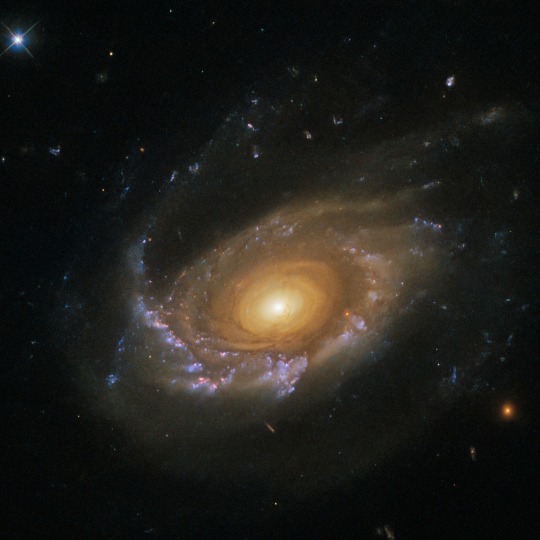
Hubble captured this remarkable image of the "Jellyfish Galaxy" (JW39) adrift 900 million lightyears away in the constellation Coma Berenices. Its nickname comes from the galaxy's trailing tendrils of baby stars.
As the galaxy moves through searing-hot plasma lurking between the larger galaxies in its cluster, the current of that intracluster medium strips away JW39's star-forming gas, so these young solar systems are forming outside the spiral disc.
Imagine the culture that might arise on a world around one of these stars in a billion years, marooned in the black between galaxies, with nights as dark as the bottom of the ocean.
63 notes
·
View notes
Text
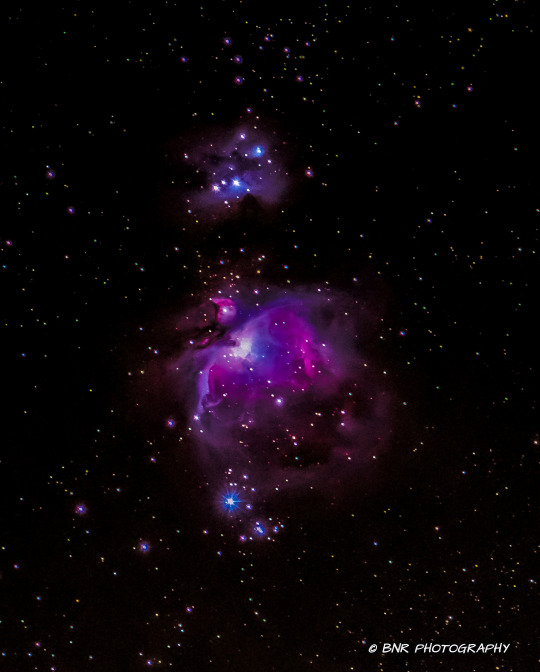
FORBIDDEN TO REBLOG IN NSFW, 18+ (Porno, Naked/Erotic), AND also NOT in TRASH BLOGS, racism, politic, guns/wars blogs, thanks.
The famous Great Nebula in Orion in the center and the Running Man Nebula at the top. RAW imaging stacked in Deep Sky Stacker and then processed in Adobe and LR. 250 images comprised to make this image.
#astronomy#galaxy#nebula#stars#space#night#telescope#time exposures#M42#gas#Orion#constellation#winter#copyright#colors#Messier object#catalog#star formation
71 notes
·
View notes
Text
hello astronomy tumblr!!😁
so erm. im participating in science olympiad and i have to study stellar evolution (i think star formation specifically but i assume ill have to know the other stuff as well) and exoplanets but uhh i have NOT studied SHIT all year and regionals are in a month so. if anyone is knowledgeable in this area. please i need help i am begging anything helps if you dont know anything then tag like a friend who might idfk please i am desperate🙏🙏🙏
#science#astronomy#stellar evolution#star formation#stars#space#exoplanets#planets#science olympiad#help please#spread the word gang . i am going to humiliate myself guys please
14 notes
·
View notes
Photo
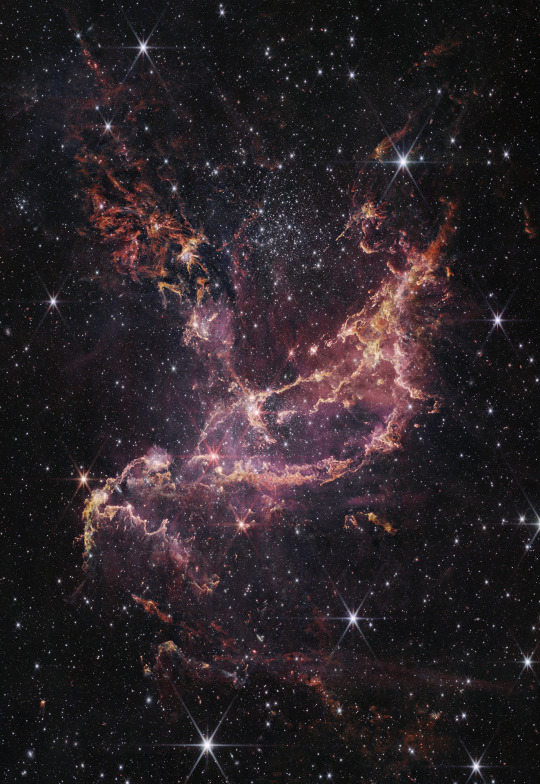


Link: NASA’s Webb Uncovers Star Formation in Cluster’s Dusty Ribbons
#NGC 346#Small Magellanic Cloud#James Webb Space Telescope#James Webb Telescope#NASA#space#star formation#astronomy#astrophotography#religion is a mental illness
52 notes
·
View notes
Text
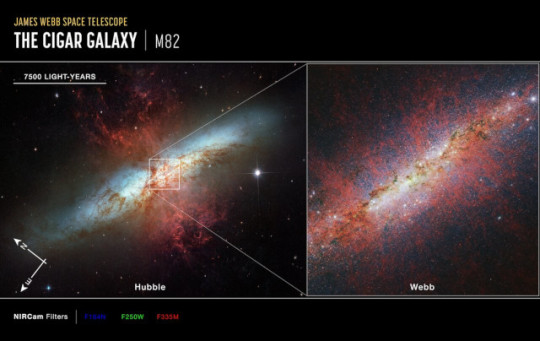
An article submitted for publication in "The Astrophysical Journal" reports a study of the exceptional rate of star formation in the M82 galaxy. A team of researchers led by Alberto Bolatto of the University of Maryland, College Park, used the James Webb Space Telescope to map powerful galactic winds that expel vast amounts of gas caused by star formation and supernova explosions.
The NIRCam instrument is the one used in particular to trace the origin of that activity back to dense star clusters in the galactic disk. This new study of M82 offers advances in understanding star formation and how this activity is affecting the galaxy.
3 notes
·
View notes
Text

#nasa#orion nebula#star formation#james webb telescope#poetry#astronomy#dark matter#writing#november#dark poetry#space poetry#life#universe#space
27 notes
·
View notes
Text
NGC 1566

Some galaxies I quite honestly could look at all day, and NGC 1566 is absolutely one of them. The beautiful spiral arms with dust lanes, and the tell tale pink nebula colouring from new born stars bombarding the hydrogen with UV. The milky yellow coloured central area with older and smaller stars and the bright centre of a supermassive black hole, thought to be around 13 million times more massive than our Sun (4.5 million for our own galaxies).
It's one of the closest Seyfert galaxies located approximately 40 million light-years away in the constellation of Dorado (The Dolphinfish), and therefore an object of interest to astronomers.
6 notes
·
View notes
Text
Cosmic Cliffs in the Carina Nebula
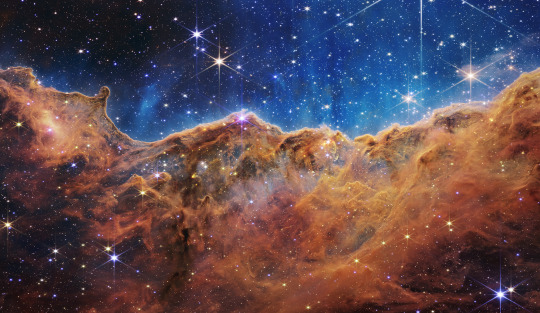
oh my gosh we're seeing some amazing photos from the new Webb Space Telescope! and this is the low-res version (full res is 137 megabytes of astro-awesomeness)
extremely massive, hot, young stars located in the center of the bubble have carved the nebula with their intense ultraviolet radiation and stellar winds, sculpting the nebula by slowly eroding it away
Webb website source: X
32 notes
·
View notes
Text
When you realise the dark spot in space in 167 was Bok's globule.

Bok globules were first observed by astronomer Bart Bok in the 1940s. In an article published in 1947, he and Edith Reilly hypothesized that these clouds were "similar to insect's cocoons" that were undergoing gravitational collapse to form new stars, from which stars and star clusters were born.[4][failed verification] This hypothesis was difficult to verify due to the observational difficulties of establishing what was happening inside a dense dark cloud that obscured all visible light emitted from within it. An analysis of near-infrared observations published in 1990 confirmed that stars were being born inside Bok globules.
And then Garou sees the Sun and then another separate glowing star right next to Earth.

Saitama's powers created another goddamn star.
Holy shit.
#opm#one punch man#opm spoilers#opm manga panels#saitama's power#garou#saitama#bok's globule#star formation
13 notes
·
View notes
Text
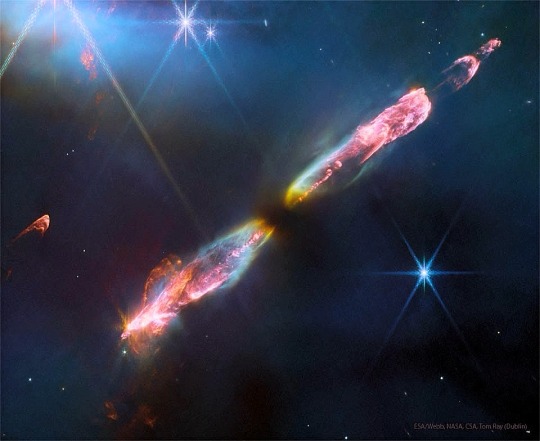
SPACEMAS DAY 4 ✨🪐🌎☄️☀️🌕
Do stars always create jets as they form? No one is sure. As a gas cloud gravitationally contracts, it forms a disk that can spin too fast to continue contracting into a protostar. Theorists hypothesize that this spin can be slowed by expelling jets. This speculation coincides with known Herbig-Haro (HH) objects, young stellar objects seen to emit jets. Pictured is Herbig-Haro (HH) 211, a young star in formation recently imaged by the James Webb Space Telescope (JWST) in infrared light and in great detail. Along with the two narrow beams of particles, red shock waves can be seen. The jets of HH 211 will likely change shape as they brighten and fade over the next 100,000 years, as research into the details of star formation continues.
Image Credit: ESA/NASA, JWST
#astronomy#space#science#universe#spacemas#day 4#star#formation#jets#spin#interstellar#interstellar gas#gravity#star formation#colours#infrared#shock waves#follow#like#reblog#the first star#the first starr#thefirststar#thefirststarr#nasa#apod#tumblr#blog#hh object#herbig haro 211
78 notes
·
View notes
Text
M51 Whirlpool Galaxy in infrared
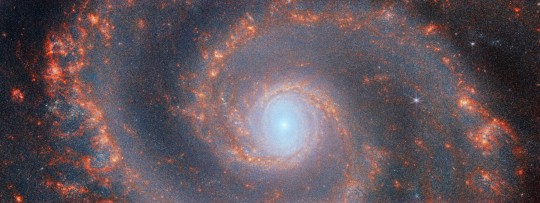
The graceful winding arms of grand-design spiral galaxy M51 reach across this image from the Webb Space Telescope. Grand-design spirals boast prominent, well-developed spiral arms like these.
In this image, dark red features trace filamentary warm dust, while red, orange, and yellow reveal pockets of ionised gas near recently formed star clusters. Stellar feedback has a dramatic effect on the medium of the galaxy and creates complex networks of bright knots and cavernous black bubbles.
Tumblr's poor photo viewer probably makes the huge, full-width image difficult to see, so I've cut it into three pieces for easier close-up viewing of the incredible detail:
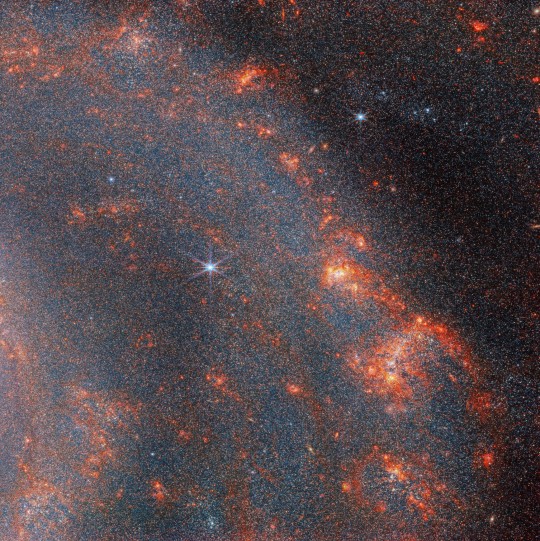


So! Many! Stars!
Unlike most, the Webb Space Telescope's infrared camera is able to peer through gas and dust to unveil countless baby stars.
NASA source with more info: X
34 notes
·
View notes
Photo
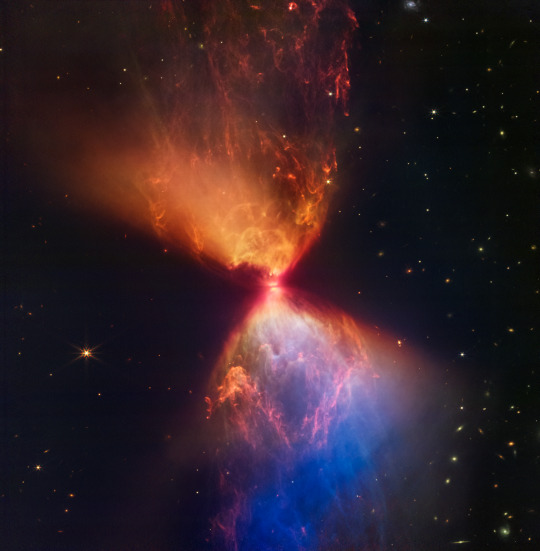
NASA’s Webb Catches Fiery Hourglass as New Star Forms | NASA
The protostar within the dark cloud L1527, shown in this image from NASA’s James Webb Space Telescope Near-Infrared Camera (NIRCam), is embedded within a cloud of material feeding its growth. Ejections from the star have cleared out cavities above and below it, whose boundaries glow orange and blue in this infrared view. The upper central region displays bubble-like shapes due to stellar “burps,” or sporadic ejections.
2 notes
·
View notes
Text
Star-forming nebulae are busy places. Unfortunately, clouds of gas and dust usually hide the action. To cut through the dust in one such region, a team of astronomers used the Atacama Large Millimeter Array (ALMA). They peered inside the Pillars of the Carina Nebula and studied molecular outflows (or jets) emanating from objects in this famous star-birth nursery.
Ph.D. student Geovanni Cortes-Rangel of the Instituto de Radioastronomía y Astrophysíca in Mexico, along with other team members from Mexico and Japan, wanted to know more about the action inside those pillars. There’s a lot going on in those pillars and in the nebula surrounding them. For one thing, a pair of massive star clusters dominates the region. Trumpler 14 and Trumpler 16 contain dozens of hot young O-type stars that are emitting huge amounts of ionizing ultraviolet radiation.
0 notes